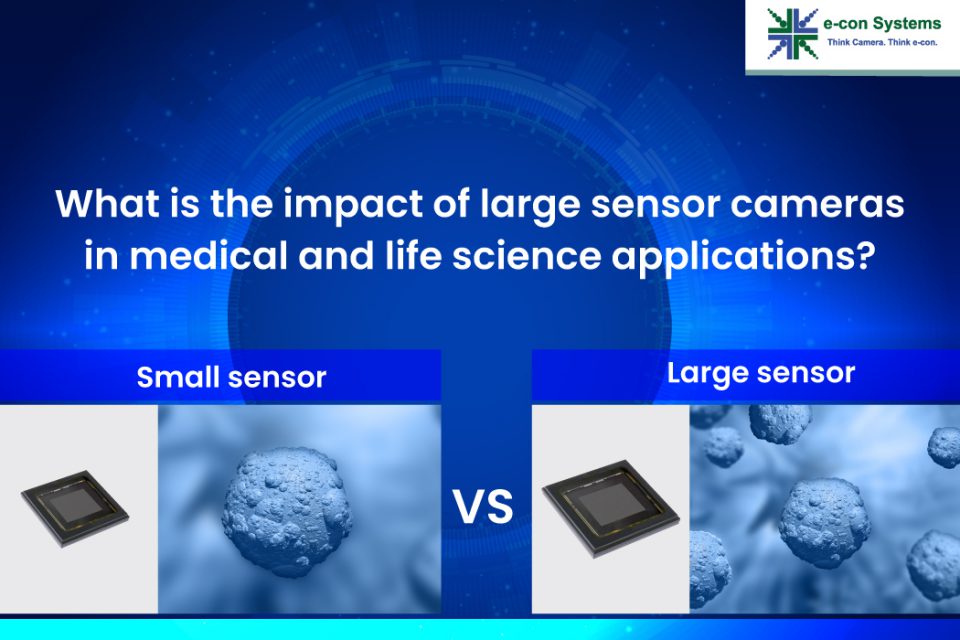Large sensor cameras have significantly impacted medical and life science applications, enabling researchers to capture high-resolution images with greater detail, accuracy, and speed. The increased sensitivity and dynamic range of these cameras have also made it possible to capture images in low-light conditions and with greater depth of field, providing insights into cellular processes and structures that were previously inaccessible.
With ongoing technological advancements, large sensor cameras will likely continue to play a critical role in medical and life science research, enabling new discoveries and insights into the complex world of biology and medicine.
In this article, we look to help you clearly understand the impact of large sensor cameras in medical and life science applications – and how they perform in low-light conditions. You’ll also find out about e-con Systems’ latest all-in-one camera, powered by the Sony Pregius IMX264 CMOS sensor, which can be a moment of truth for your product.
What are large sensor cameras?
Large sensor cameras are digital cameras that have larger image sensors than traditional cameras. The image sensor is part of the camera that captures the light and converts it into an electronic signal, which is then processed to create a digital image. The size of the image sensor is measured in megapixels, which indicates the number of pixels that can be captured in a single image.
The larger size of the image sensor in large sensor cameras offers several advantages over traditional cameras. These include:
Advantages of large sensor cameras
- Large sensor cameras allow for higher resolution images with greater detail and clarity. This is because the larger sensor can capture more light and detail, resulting in higher-quality images with less noise and distortion.
- Large sensor cameras provide a wider dynamic range, which means that they can capture a greater range of tones and colors, resulting in more accurate and realistic images.
- Large sensor cameras are better at capturing images in low light conditions, as they can capture more light and detail with less noise.
Impact of large sensor cameras in medical and life science applications
Role of large sensor cameras in medical applications
Large sensor cameras have revolutionized the field of medical imaging, enabling doctors and researchers to capture high-quality images of the human body with unprecedented detail and accuracy. For example, digital X-ray systems use large sensor cameras to capture high-resolution images of the body, allowing doctors to identify and diagnose medical conditions with greater precision.
Similarly, large sensor cameras are used in computed tomography (CT) scans to create three-dimensional images of the body, which can be used to identify tumors and other abnormalities.
Role of large sensor cameras in life science applications
These cameras are also used in a range of life science applications, including microscopy and imaging of biological samples. Large sensor cameras have been particularly useful in fluorescence microscopy, which uses fluorescent molecules to label and visualize specific structures within cells and tissues.
Large sensor cameras enable researchers to capture high-resolution images of these structures, providing a greater level of detail and allowing for more accurate analysis of cellular processes.
These cameras have made it possible to capture images of living cells and tissues with greater speed and accuracy. This is particularly important in live cell imaging, where it is necessary to capture images of dynamic cellular processes in real time. They also enable researchers to capture high-speed, high-resolution images of living cells, making it possible to study processes such as cell division and migration in greater detail.
How large sensor cameras perform in low-light conditions
Another major differentiator of large sensor cameras is that they are extremely capable of capturing good-quality images in low-light conditions. It means that they can be confidently used in medical and life science processes such as fluorescence microscopy and live cell imaging. Hence, large sensor cameras are important for applications where the sample is sensitive to light, as the use of lower-intensity light sources can reduce sample damage.
How do they do this?
Large sensor cameras generally perform better in low-light conditions compared to smaller sensor cameras. This is because larger sensors are able to capture more light, allowing for better image quality in low-light environments. However, it’s important to note that other factors, such as lens quality, can also play a significant role in low-light performance.
Large sensor cameras by e-con Systems for medical and life science applications
e-con Systems has been offering camera solutions for the medical industry for more than a decade now. We are the pioneers in embedded vision solutions – having integrated our vision solutions into medical devices of 100+ customers and helping launch them to the market. We understand that every medical or life science product has its own requirements – so we overcome major industry challenges by ensuring that sensors are engineered for optimum performance & withstanding physical damage. We also offer integrated imaging modules, including ISP, optics, cables, software, etc.
See3CAM_50CUG, one of our latest releases, is a 5MP high-sensitivity fixed focus camera based on the Sony Pregius IMX264 CMOS sensor. It comes with powerful back-illuminated pixel technology and a large pixel size of 3.45µm to ensure high sensitivity and quantum efficiency. Some of its other features are:
- Global shutter readout
- High dynamic range
- High frame rate images without any motion blur
- IR sensitivity
- C-mount lens holder
If you need help integrating camera solutions into your medical or life science application, please write to us at camerasolutions@e-consystems.com. You can also check out our Camera Selector page to see our camera portfolio.

Balaji is a camera expert with 18+ years of experience in embedded product design, camera solutions, and product development. In e-con Systems, he has built numerous camera solutions in the field of ophthalmology, laboratory equipment, dentistry, assistive technology, dermatology, and more. He has played an integral part in helping many customers build their products by integrating the right vision technology into them.




